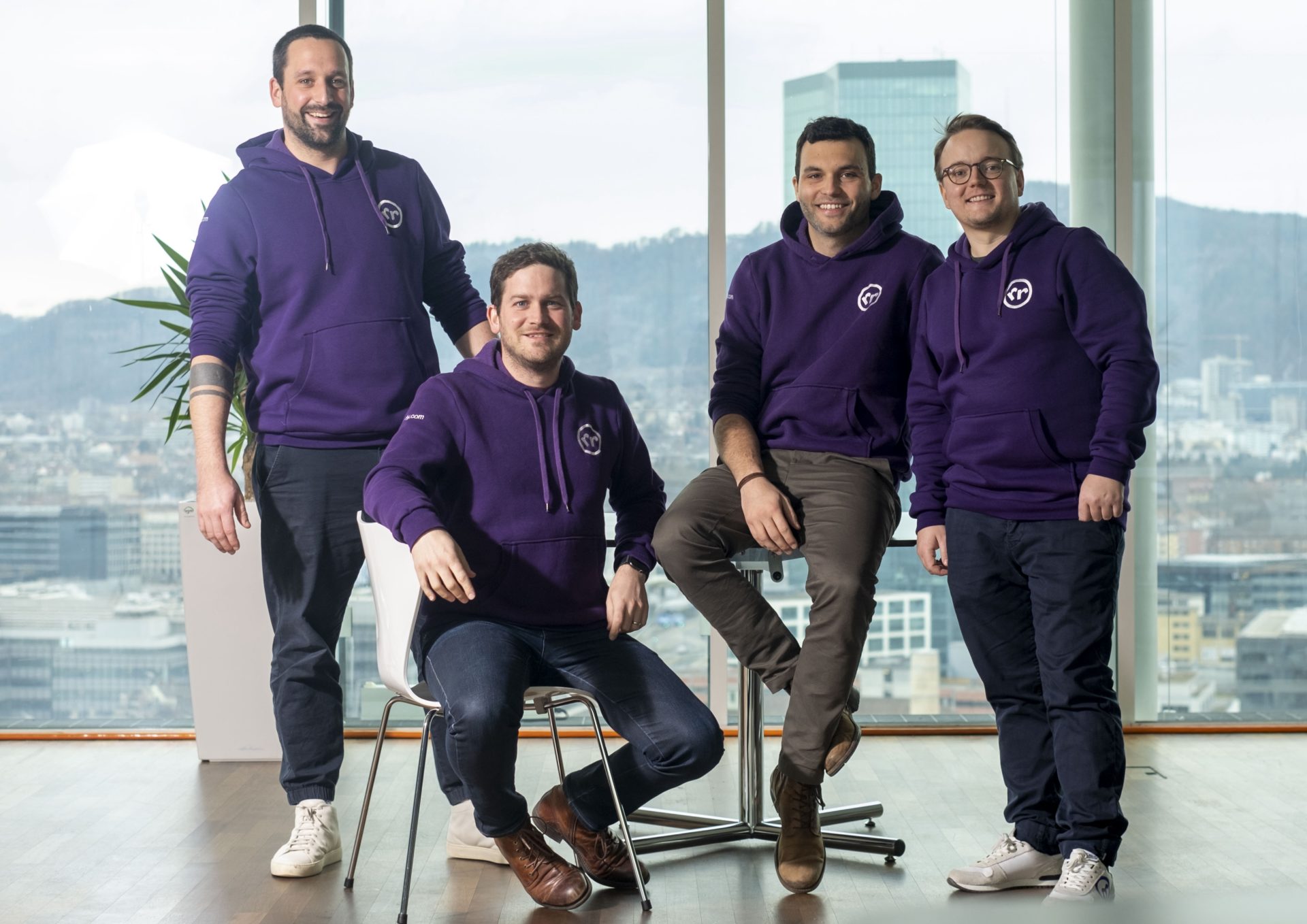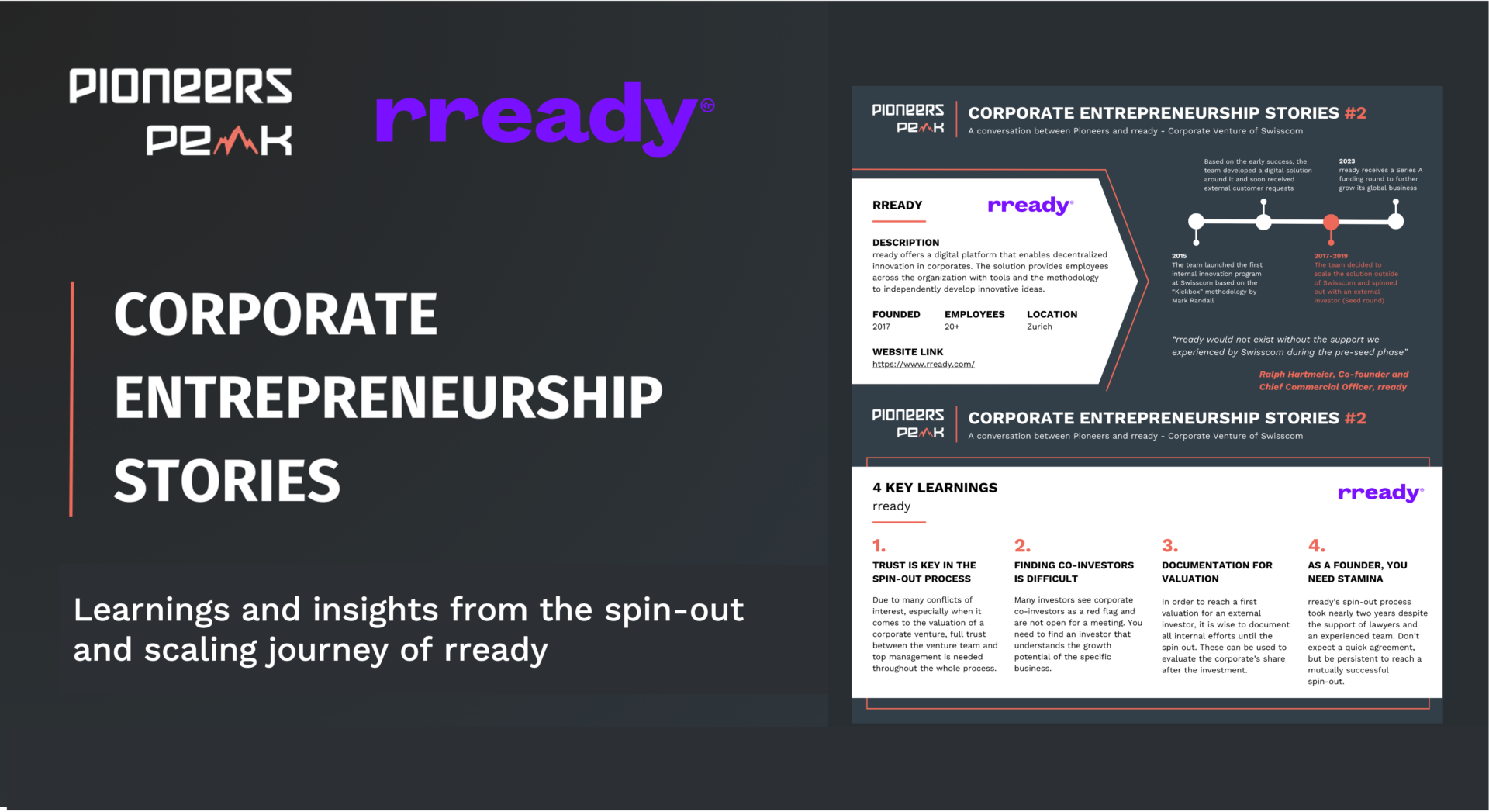
Corporate Entrepreneurship Stories #2 – rready – Part 2
Part 2 – The process of getting external investment and advantages, and disadvantages of being a corporate venture vs. a “normal” startup.
Having looked at rready’s solutions, the founding team, and early developments in part #1, we now want to dive deeper into the investment process, the advantages and disadvantages of being a corporate venture vs. a “normal” startup as well as the future growth path of rready.
Michael Lunzer, Pioneers:
First, congrats on finding an external investor and spinning rready out! I would be curious to dive deeper into this topic. When looking for investments in the startup world, founders would usually call for a specific funding round and state their company valuation. What does the process look like for a corporate venture?
Ralph Hartmeier:
Good question. There had been very few examples before us that we could learn from, so we had to test and learn on the go. In the end, we tried to bring exactly the startup logic you mentioned to the corporate world. We documented and tracked everything we did for rready during our Swisscom jobs. Additionally, we evaluated all services and benefits we received from Swisscom until the external investment.
All these Swisscom “expenses” were summed up, valued, and treated like a Pre-Seed investment [early-stage investment in a startup, usually pre-product stage] from Swisscom Ventures. That way, the external investor was then co-investing in a Seed round while Swisscom Ventures as the Pre-Seed investor also stayed on board. For Swisscom Ventures this was a win-win situation as they could add a venture to their portfolio without actually investing in it. For Swisscom itself, it provided the chance for a financial return, and cost savings by shifting employees as well as promoting a nice success story.
One important thing to add is that full trust between us and Swisscom was essential in the entire process. Surely, there was a conflict of interest during the last months of the spin-out process between being the corporate venture’s founder and an employee of Swisscom. Naturally, we would have had the incentive to ascribe as little working time as possible to rready to lower Swisscom’s claim for shares. But by being highly transparent in the whole process, we could overcome the barrier of mistrust and got all stakeholders aligned.
That is an important learning for sure. So with the external investment, did rready basically become a conventional startup? Or something in between a corporate venture and a startup? What changed?
With the investment, we became a startup, yes. We cut most ties to Swisscom and also to the outside world to promote ourselves as an innovative, independent company. This brings along of course many advantages but also disadvantages compared to being a corporate venture.

The four co-founders of rready – Reto, Dave, Ralph and Vinz (from left to right)
”We don't just offer a digital innovation tool, but also the methodology behind it. This is where value is created: The validation and execution of ideas.
What are the advantages of being a startup vs. a corporate venture?
First, we need to make it very clear: rready would not exist without the support we experienced by Swisscom during the pre-seed phase. Not only the investment in us and the soon-to-be-product were valuable but the testing environment of a big corporate, the knowledge, and support by other Swisscom employees was incredibly valuable.
The biggest advantage we saw after the spin-out process was with regards to hiring key talent. By independently building up our own brand and being a “startup”, we could recruit employees fitting to our environment and culture. When we were still operating under the Swisscom brand, we received mostly applications from corporate managers. After the re-branding, we suddenly received many applications from people fitting much better to our startup setting. By being in charge of hiring, we could also create leaner and faster hiring processes than in a corporation. These faster processes reduced dropout rates in our hiring funnel and led to higher hiring conversions.
Besides improved hiring, we saw a strong rise in investor interest in rready, which made follow-up investments much easier.
Any disadvantages?
Well, surely you can feel that you are on the open market and you take a larger part of the risk. But that’s part of the game.

So, summing it up – when would you recommend a venture like yours, that does not fit the core business, to take the step of spinning out?
In the beginning, we profited strongly from the credibility of Swisscom, especially in Switzerland. As employees of a corporate, you are more easily invited to conferences, as speakers for instance. Additionally, it helps gain trust and win the first test customers. However, once you have a product and want to scale your team, being within the corporate environment will reduce the speed. It does not allow for employee stock options and other incentives for key talent. Once you want to scale, it is probably the best time to cut ties and spin out.
Thanks for these insights. You just received USD 4 Mio Series A funding from several investors. How do you plan to use it and what are your goals now?
So far, we focused strongly on growth. We aim to continue this path with a solid growth rate per year but also target profitability and enhance our product with AI-features to quicker and better derisk ideas.
And Swisscom? What does the company expect and when can they expect a positive return?
On paper, the investment already brought an ROI for Swisscom [laughs]. But as for any other startup investors, it is only in the books if the exit has been successfully executed.
Last question, as someone who has experienced all three roles– corporate venture founder, startup founder, and innovation manager – what recommendation would you offer corporates that aim to build successful ventures?
Firstly, be clear about what you want, which will then of course also relate to a certain risk appetite. Secondly, set realistic timelines for returns. It takes time and maybe several pivots to build a successful venture. Thirdly, in my opinion, most ventures fail at the end because not enough good validation has been done in the beginning. Let people do their homework early on and focus on a data-driven approach to validate the most critical hypothesis. Moreover, a transparent ROI calculation and measurement along the way is important to be successful; and take decisions on the way. Lastly, you need passionate and persistent people who stand up more often than they fall.
Thanks a lot for this very insightful conversation and all the best!
Do you want to learn more about how we can support your corporate venture building activities?
Schedule a brief introductory call with our Innovation Manager Michael Lunzer. Simply send a quick email to michael.lunzer@pioneers.io.

Michael Lunzer
Innovation Manager
